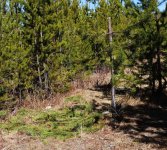uniface
Silver Member
Native Americans reached Polynesia 800 years ago and interbred with local islanders – centuries before European explorers arrived in the Pacific.
Researchers from the US and Mexico used large-scale genetic analyses to show that modern-day Polynesian populations contain traces of Native American DNA.
Statistical analysis revealed that prehistoric Polynesian populations first met and interbred with people from what is today Colombia around the year 1,150 AD.
This event – which took place on the South Marquesas islands – occurred at roughly the same time Polynesians first arrived in the area from the west.
The finding finally confirms a long-running theory that the two groups had met – and explains why sweet potatoes from the Americas can be found in Polynesia.
The team's large-scale modern genetic analysis was able to prove what studies of the sweet potato itself and ancient bones could not.
'We found identical-by-descent segments of Native American ancestry across several Polynesian islands,' Dr Ioannidis said.
This, explained, provided 'conclusive evidence' for a 'shared contact event' prehistoric Polynesian and Native American peoples – one in which children with a parent from each group were born.
Further analysis of the genetic signals revealed that the event occurred around 1,150 AD – during Europe's Middle Ages – and, Dr Ioannidis said, 'around the time that these islands were originally being settled by native Polynesians.'
Alongside this, the team were also able to confirm the previous theory that the Native Americans who interacted with the Polynesians came from the region that, today, is Colombia.
The full findings of the study were published in the journal Nature.
REVEALED: How Native Americans reached Polynesia 800 years ago by raft and interbred with islanders - centuries before European explorers arrived in the Pacific - Madness Hub
Researchers from the US and Mexico used large-scale genetic analyses to show that modern-day Polynesian populations contain traces of Native American DNA.
Statistical analysis revealed that prehistoric Polynesian populations first met and interbred with people from what is today Colombia around the year 1,150 AD.
This event – which took place on the South Marquesas islands – occurred at roughly the same time Polynesians first arrived in the area from the west.
The finding finally confirms a long-running theory that the two groups had met – and explains why sweet potatoes from the Americas can be found in Polynesia.
The team's large-scale modern genetic analysis was able to prove what studies of the sweet potato itself and ancient bones could not.
'We found identical-by-descent segments of Native American ancestry across several Polynesian islands,' Dr Ioannidis said.
This, explained, provided 'conclusive evidence' for a 'shared contact event' prehistoric Polynesian and Native American peoples – one in which children with a parent from each group were born.
Further analysis of the genetic signals revealed that the event occurred around 1,150 AD – during Europe's Middle Ages – and, Dr Ioannidis said, 'around the time that these islands were originally being settled by native Polynesians.'
Alongside this, the team were also able to confirm the previous theory that the Native Americans who interacted with the Polynesians came from the region that, today, is Colombia.
The full findings of the study were published in the journal Nature.
REVEALED: How Native Americans reached Polynesia 800 years ago by raft and interbred with islanders - centuries before European explorers arrived in the Pacific - Madness Hub
Upvote
0




